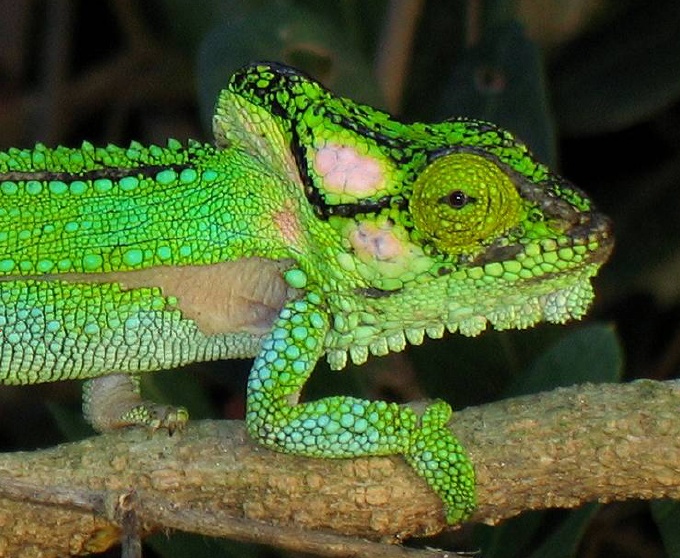Superregnum: Eukaryota
Regnum: Animalia
Subregnum: Eumetazoa
Cladus: Bilateria
Cladus: Nephrozoa
Superphylum: Deuterostomia
Phylum: Chordata
Cladus: Craniata
Subphylum: Vertebrata
Infraphylum: Gnathostomata
Superclassis: Tetrapoda
Cladus: Reptiliomorpha
Cladus: Amniota
Classis: Reptilia
Cladus: Eureptilia
Cladus: Romeriida
Subclassis: Diapsida
Cladus: Sauria
Infraclassis: Lepidosauromorpha
Superordo: Lepidosauria
Ordo: Squamata
Cladus: Unidentata Episquamata Toxicofera
Subordo: Iguania
Infraordo: Acrodonta
Familia: Chamaeleonidae
Subfamilia: Chamaeleoninae
Genus: Bradypodion
Species: Bradypodion damaranum
Name
Bradypodion damaranum (Boulenger, 1887)
Type locality: Designata (fide Fitzsimons 1943: 166): Knysna, Cape Province.
Holotype: (Syntypes): BMNH 1946.9.4.78—79 (2 specimens).
Synonyms
Chamaeleon damaranus Boulenger 1887
Chamaeleo pumilus damaranus — Hillenius 1959: 63.
Bradypodion pumilum damaranum — Klaver & Böhme 1997
References
Boulenger, G.A. 1887. Catalogue of the Lizards in the British Museum (Nat. Hist.) III. Lacertidae, Gerrhosauridae, Scincidae, Anelytropsidae, Dibamidae, Chamaeleontidae. London: 575 pp.
Pianka, E.R. & Vitt, L.J. 2003. Lizards – Windows to the Evolution of Diversity. University of California Press, Berkeley, 347 pp. [review in Copeia 2004: 955].
Nečas, P. 1999. Chameleons – Nature's Hidden Jewels. Edition Chimaira, Frankfurt; 348 pp. ISBN 3-930612-04-6 (Europe). ISBN 1-57524-137-4 (USA, Canada). Reference page.
Bradypodion damaranum at the New Reptile Database. Accessed on 11 March 2008.
Vernacular names
čeština: Chameleon nádherný
English: Knysna dwarf chameleon
The Knysna dwarf chameleon (Bradypodion damaranum) is a species of dwarf chameleon in the Bradypodion ("slow footed") genus that is endemic to South Africa. It is a forest dweller, found only in a limited range in the afromontane forests near Knysna, South Africa, and in certain surrounding areas.
Description
This species has the longest tail of all the Bradypodion species. As with most chameleons, its tongue is twice the length of its body and it can be shot out of its mouth using a special muscle in the jaw. This gives the chameleon the ability to catch insects some distance away. The Knysna dwarf chameleon has a prominent casque and has bright green to bluish skin, decorated with purple, yellow and pink hues. It is up to 180 mm (7.1 in) total length.[3]
Taxonomy
In the past, most South African dwarf chameleons were considered to be a subspecies of one Cape Bradypodion species[4] This is now known to be wrong, however; B. damaranum does not appear to have any particularly close living relatives. Like the Cape dwarf chameleon, it seems to be a basal offshoot of the ancestral stock which gave rise to all Bradypodion chameleon species.[5]
Male Knysna dwarf chameleon, submissive coloration
Distribution
The Knysna dwarf chameleon is distributed on the south-facing slopes of the Outeniqua and Tsitsikamma Mountains down to the coast in the eastern Western Cape and western Eastern Cape.[3]
Habitat
The normal habitat of Bradypodion damaranum is Fynbos and Afromontane Forest; it is often found in gardens.[3]
Urban environments
This chameleon also readily adapts to living in gardens. However, not all suburban areas are suitable. Chameleons can only survive in gardens with much bushy and varied vegetation. Most suitable are bushes and small trees which have fine foliage or thin twigs that chameleons can grasp with their hands and use as perches. Pruning or trimming of bushes will usually injure and kill the chameleons. They will avoid lawns too. Chameleons wander and, in suburbs with smaller gardens, they also avoid properties which are not connected to larger "green corridors" which extend over several properties.[6]
In urban areas its predators are mainly domestic cats - a non-native, introduced predator, against which chameleons are relatively defenseless. Other predators include a range of urban and introduced bird species such as crows. Certain gardening practices such as using insecticides or hedge trimmers can also kill off urban populations.[7][8][9]
References
Tolley, K.A. (2018). "Bradypodion damaranum". IUCN Red List of Threatened Species. 2018: e.T42679109A115667188. doi:10.2305/IUCN.UK.2018-2.RLTS.T42679109A115667188.en. Retrieved 20 November 2021.
"Appendices | CITES". cites.org. Retrieved 2022-01-14.
"Knysna Dwarf Chameleon Bradypodion damaranum". Biodiversity Nature. Retrieved 16 October 2016.
(e.g. Klaver & Böhme 1997)
(Tolley et al. 2004)
K.A. Tolley; R. Raw; R. Altwegg; J. Measey: Chameleons on the move: survival and movement of the Cape dwarf chameleon, Bradypodion pumilum, within a fragmented urban habitat. African Zoology 45(1): 99–106 (April 2010)
Pdf. list of CITES-protected Endangered Species.
A.D.Rebelo: Movement of the Cape dwarf chameleon (Bradypodion pumilum): are they vulnerable to habitat fragmentation? Department of Biological Sciences, University of Cape Town. 2014
"FAQ - Prof. K. Tolley". Archived from the original on 2015-09-05. Retrieved 2015-09-16.
Tolley K. and Burger M. 2007. Chameleons of Southern Africa. Struik, Cape Town
Tolley, K.A. et al. 2006. Biogeographic patterns and phylogeography of dwarf chameleons (Bradypodion) in an African biodiversity hotspot. Molecular Ecology 15:781-793.
Adcham profile
The Dwarf Chameleon Project at Wildcliff Nature Reserve
Retrieved from "http://en.wikipedia.org/"
All text is available under the terms of the GNU Free Documentation License


